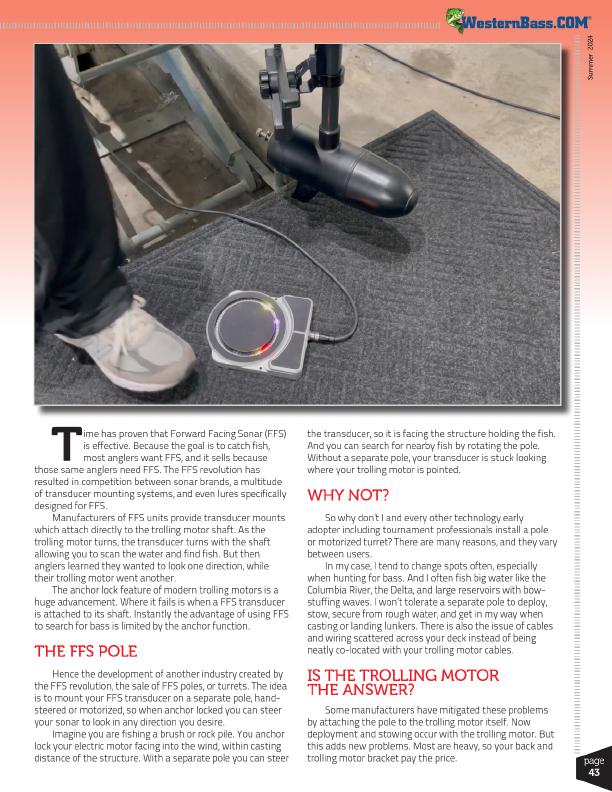
®
Summer 2024
T
ime has proven that Forward Facing Sonar (FFS)
is effective. Because the goal is to catch fish,
most anglers want FFS, and it sells because those same anglers need FFS. The FFS revolution has
resulted in competition between sonar brands, a multitude
of transducer mounting systems, and even lures specifically
designed for FFS.
Manufacturers of FFS units provide transducer mounts
which attach directly to the trolling motor shaft. As the
trolling motor turns, the transducer turns with the shaft
allowing you to scan the water and find fish. But then
anglers learned they wanted to look one direction, while
their trolling motor went another.
The anchor lock feature of modern trolling motors is a
huge advancement. Where it fails is when a FFS transducer
is attached to its shaft. Instantly the advantage of using FFS
to search for bass is limited by the anchor function.
THE FFS POLE
Hence the development of another industry created by the FFS revolution, the sale of FFS poles, or turrets. The idea is to mount your FFS transducer on a separate pole, hand- steered or motorized, so when anchor locked you can steer your sonar to look in any direction you desire.
Imagine you are fishing a brush or rock pile. You anchor lock your electric motor facing into the wind, within casting distance of the structure. With a separate pole you can steer
the transducer, so it is facing the structure holding the fish. And you can search for nearby fish by rotating the pole. Without a separate pole, your transducer is stuck looking where your trolling motor is pointed.
WHY NOT?
So why don’t I and every other technology early adopter including tournament professionals install a pole or motorized turret? There are many reasons, and they vary between users.
In my case, I tend to change spots often, especially when hunting for bass. And I often fish big water like the Columbia River, the Delta, and large reservoirs with bow- stuffing waves. I won’t tolerate a separate pole to deploy, stow, secure from rough water, and get in my way when casting or landing lunkers. There is also the issue of cables and wiring scattered across your deck instead of being neatly co-located with your trolling motor cables.
IS THE TROLLING MOTOR THE ANSWER?
Some manufacturers have mitigated these problems by attaching the pole to the trolling motor itself. Now deployment and stowing occur with the trolling motor. But this adds new problems. Most are heavy, so your back and trolling motor bracket pay the price.
page 43